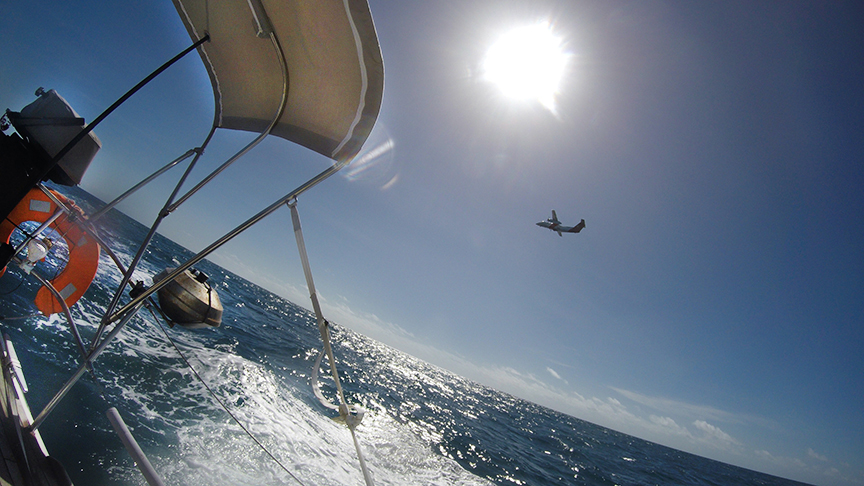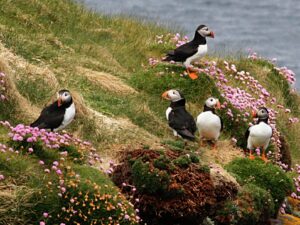The ability to sail off into the sunset, anchor in secluded bays, and access remote islands is the dream of many. But can you actually explore the world as you please? Well, sort of.
Very basically, the United Nations Convention on The Law of the Sea provides for absolute freedom of navigation on the seas outside territorial waters. It also allows for “innocent passage” through territorial waters and Exclusive Economic Zones.
You can sail around the globe and across every ocean without actually entering a country. But part of the adventure of sailing is to explore other countries and cultures. So how do you enter a country by boat? Here’s where things can get complicated.

Planning our passage and entry into Australia. Notes on the requirements for entry are on the right-hand side of the photo. Photo: Kate Collins
Entering a country by boat in some ways is like entering by aircraft. You still require the appropriate visas and a passport and must go through an immigration process and perhaps bio-security. Unlike flying, however, the process of entering and leaving a port is not handled by the airline. The skipper herself must complete it.
The boat makes entry complicated
Customs is more complex than filling out some duty-free allowance forms because you arrive with a large and expensive asset — the boat! The boat requires its own set of paperwork.
In general, you need to enter at an official Port of Entry. Not every port is set up to clear a foreign boat. The harbor master handles the entry and exit, while the crew goes through immigration and the boat through a customs process.
Exactly what this involves varies significantly from country to country. Requirements may also vary depending on your previous port of call, what passport you carry, and where the boat is flagged.

The check-in/out process taped to the wall in Phuket, Thailand. Photo: Sean Collins
Costs also vary from country to country. Entry into some countries is free or requires just a small payment or perhaps visa fees. Others charge considerable sums that may deter the budget-conscious sailor.
Best to avoid certain countries
Cruising in Myanmar, for example, costs up to $3,500 for a five-day visit. Fees include a cruising fee, marine department fees, guide fees (it is mandatory to have a guide on your boat for your entire time in Myanmar), visa fees, and a national park fee. You are also required to engage an agent (for a fee!) to collect your documents and fees –- cash only, in clean U.S. bills.
You must always carry a mound of paperwork: proof of boat ownership, registration, insurance for the boat, passports, visas, vaccination records, proof of health insurance, and an inventory of items that may need to be declared on entry, such as radios, EPIRBs, etc.
Courtesy flags for each country you intend to visit and the “Q” or quarantine flag should also be carried. You may have to fly the Q flag before checking into a country. It is a nautical tradition and good manners to fly the flag of the country you are visiting. Failure to do so may be a breach of maritime etiquette. Some countries take this more seriously than others. In Indonesia, for example, the Indonesian courtesy flag must be larger than the boat’s national flag.

The Indonesian courtesy flag flies off the starboard flag halyard, as required. Photo: Kate Collins
Dealing with corruption
Most countries — but not all — differentiate between small pleasure craft and large commercial vessels. When they don’t, the entry process becomes extremely arduous. Some countries suffer corruption and thus behave inconsistently. You can be waved through or you may need to bribe.
Other places are so complex and expensive that they deter all but the most fearless. Vietnam, for example, generally falls into the “too hard” category, due to the complexity of the immigration process, the cost, and the uncertainty. Boats have been impounded for lacking the correct documentation, even though it’s unclear what the correct documentation is.
The Galapagos also has an onerous entry process. A boat must have prior permission to enter and may only do so through a single port. An agent is mandatory. On entry, any number of officials may board your ship — Port Master, Immigration, Galapagos National Park, Ministry of Environment, Biosecurity, Health, Navy/Customs. There are restrictions on where you can travel, live-aboard guides are required to land in the national park, dinghies may not be left ashore, and someone must stay on the boat at all times.

Getting all the right stamps to enter Malaysia by boat. Photo: Kate Collins
Some countries simple
Checking into Malaysia in Langkawi, however, is simple. We were cruising and racing in and out of Langkawi in 2016. We simply pulled into the marina and walked down to the Port building. Immigration, Customs, and the Harbor Master had adjacent offices, and we completed all the paperwork within an hour. As of January 2024, a Malaysia Digital Arrival Card (MDAC) is required before entry, but the process remains simple.

The chart plotter shows the busy waters around Singapore. Photo: Kate Collins
Entering Singapore, the second busiest port on Earth, is quite the experience. On our last visit, we had to clear at sea before landing. This involved motoring (sailing is not allowed) to a predetermined location to meet CIQ (Customs, Immigration, Quarantine) officials.
We had a route — motor through the anchorages, watch for ships coming in and out of Tanjong Pelepas, then proceed across the Sinki Fairway, behind Bukom Island, and straight to Sisters Island CIQ. It was so crowded that at times, we wondered whether we were allowed to be there. It was like riding a bike on a freeway.
On arrival, the CIQ vessel met us and gave us directions over a loud hailer. We then had to place all our documentation in a fishing net on a pole, which they drew back to their boat and processed. With documents verified and passports stamped, they stretched the fishing net back to us and we removed our validated documents. It is vaguely disappointing that this quaint service has recently become out of date.

Some countries are strict on how you present at their consulates to arrange visas. Shabby clothes and flip-flops are considered disrespectful. Sean Collins was once turned away from the Indonesian Embassy in Singapore for wearing dress shorts. Uncovered knees are seen as disrespectful. Photo: Sean Collins
Even Europe has its challenges
Some regions, such as the Schengen Area in Europe, have their unique challenges. This area comprises 27 European countries and has effectively abolished internal borders. This allows sailors to navigate the entire region without frequent passport checks.
The hiccup here for the non-EU sailor is the visa-free period issued for Schengen is 90 days in 180. I am a dual Canadian-Australian citizen so may stay only three months in every six in the region. This requires some careful planning to ensure I don’t exceed the time limit. The boat itself, however, can stay for up to two years.
Australia, New Zealand, many Pacific nations, and some remote places such as the Galapagos have extremely strict biosecurity. This is due both to their unique flora and fauna and their lack of diseases such as foot-and-mouth. You have to be extra vigilant to avoid having prohibited items on board, including any insects or sea critters that have hitched a ride.

The Australian Border Force overflies a yacht entering Australian waters north of Darwin. Photo: Sean Collins
Strict biosecurity
Entering Australia, you must declare any prohibited items and Biosecurity will dispose of them. Failure to declare such items results in significant fines. Before arriving, for example, we ate all our fruit, vegetables, cheese, honey, and meat. As part of the clearance process, Biosecurity inspected the boat, and a diver checked the bottom and pumped a bio-foul through all the saltwater intakes. The boat beside us had sniffer dogs aboard.
Navigating the bureaucracy of global travel by boat can be overwhelming. But help is at hand. There are numerous resources to assist. Most countries detail entry by boat on their border force/immigration websites. There are cruiser forums, websites, cruising guides, and books. There is always someone who has done it, and chats with fellow sailors about your plans can yield some very useful information.
A few helpful sites are:

A modest entry point into Indonesia. Photo: Kate Collins






